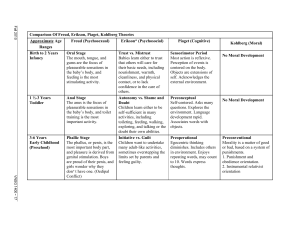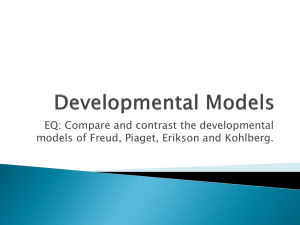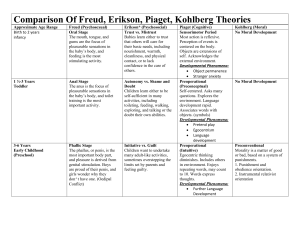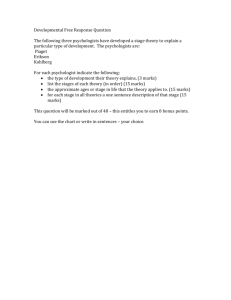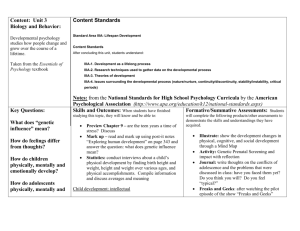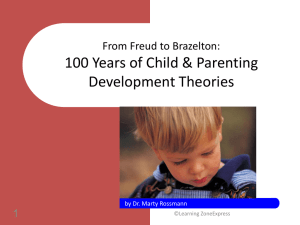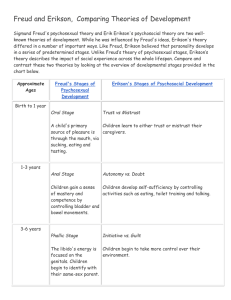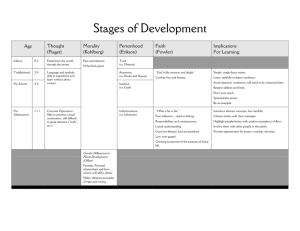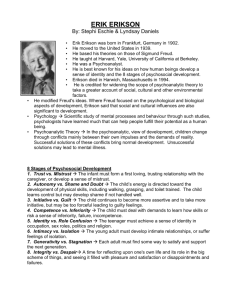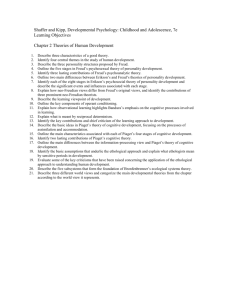Freud, Erikson, Piaget, Kohlberg Theories Comparison Chart
advertisement
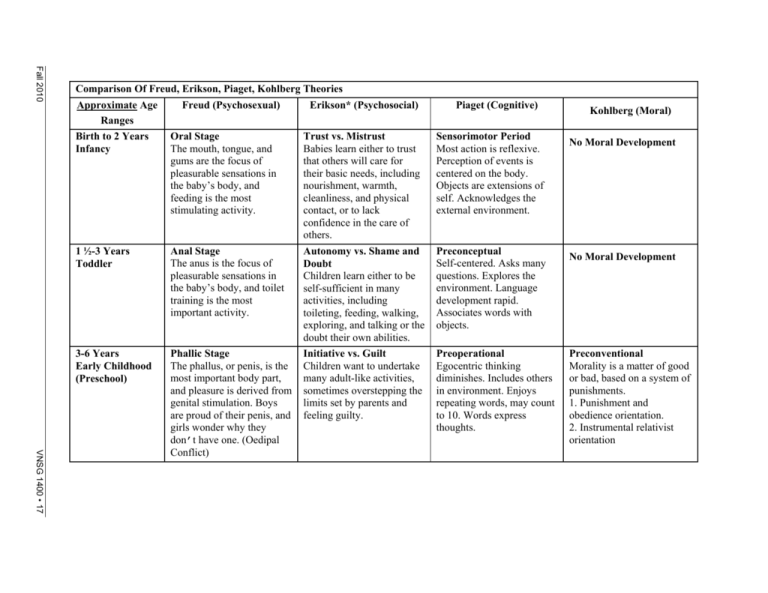
Fall 2010 Comparison Of Freud, Erikson, Piaget, Kohlberg Theories Approximate Age Ranges Freud (Psychosexual) Erikson* (Psychosocial) Piaget (Cognitive) VNSG 1400 • 17 Birth to 2 Years Infancy Oral Stage The mouth, tongue, and gums are the focus of pleasurable sensations in the baby’s body, and feeding is the most stimulating activity. Trust vs. Mistrust Babies learn either to trust that others will care for their basic needs, including nourishment, warmth, cleanliness, and physical contact, or to lack confidence in the care of others. Sensorimotor Period Most action is reflexive. Perception of events is centered on the body. Objects are extensions of self. Acknowledges the external environment. 1 ½-3 Years Toddler Anal Stage The anus is the focus of pleasurable sensations in the baby’s body, and toilet training is the most important activity. Autonomy vs. Shame and Doubt Children learn either to be self-sufficient in many activities, including toileting, feeding, walking, exploring, and talking or the doubt their own abilities. Preconceptual Self-centered. Asks many questions. Explores the environment. Language development rapid. Associates words with objects. 3-6 Years Early Childhood (Preschool) Phallic Stage The phallus, or penis, is the most important body part, and pleasure is derived from genital stimulation. Boys are proud of their penis, and girls wonder why they don’t have one. (Oedipal Conflict) Initiative vs. Guilt Children want to undertake many adult-like activities, sometimes overstepping the limits set by parents and feeling guilty. Preoperational Egocentric thinking diminishes. Includes others in environment. Enjoys repeating words, may count to 10. Words express thoughts. Kohlberg (Moral) No Moral Development No Moral Development Preconventional Morality is a matter of good or bad, based on a system of punishments. 1. Punishment and obedience orientation. 2. Instrumental relativist orientation Fall 2010 Comparison Of Freud, Erikson, Piaget, Kohlberg Theories Approximate Age Ranges Freud (Psychosexual) Erikson* (Psychosocial) Piaget (Cognitive) 7-11 Years Middle Childhood Latency Not a stage but an interlude, when sexual needs are quiet and children put psychic energy into conventional activities like schoolwork and sports. Industry vs. Inferiority Children busily learn to be competent and productive in mastering new skills, or feel inferior an unable to do anything well. Concrete Operations Solves concrete problems. Begins to understand relationships such as size. Understands right and left. Cognizant of viewpoints. Conventional Level Morality seen as following the rules of society. Tries to be “good.” 1. “Good boy, good girl.” 2. Law - and - order orientation. 12-18 Years Adolescence Genital Stage The genitals are the focus of pleasurable sensations, and the young person seeks sexual stimulation and sexual satisfaction in heterosexual relationships. Identity vs. Role Confusion Adolescents try to figure out “Who am I?” They establish sexual, political, and career identities or are confused about what roles to play. Formal Operations Uses rational thinking. Reasoning is deductive and futuristic. Postconventional Morality consists of standards beyond specific group or authority figure. 1. The social contract orientation. 2. The universal ethical principle orientation. 3. Mystical and religious reflection. 18-40 Years Adulthood Freud believed that the genital stage lasts throughout adulthood. He also said that the goal of a healthy life is “to love and to work well.” Intimacy vs. Isolation Young adults seek companionship and love with another person or become isolated from others by fearing refection or disappointment. Kohlberg (Moral) VNSG 1400 • 18 Fall 2010 Comparison Of Freud, Erikson, Piaget, Kohlberg Theories Approximate Age Ranges 40-65 Years Middle Years 65 - Years Late Adulthood Freud (Psychosexual) Erikson* (Psychosocial) Piaget (Cognitive) Kohlberg (Moral) Generativity vs. Stagnation Middle-aged adults contribute to the next generation by performing meaningful work, creative activities, and/or raising a family, or become stagnant and inactive. Integrity vs. Despair Older adults try to make sense out of their lives, whether seeing life as a meaningful whole or despairing at goals never reached and questions never answered. *Although Erikson describes two extreme resolutions to each crisis, he recognizes that there is a wide range of outcomes between these extremes and that most people arrive at some middle course. VNSG 1400 • 19
